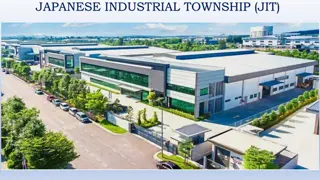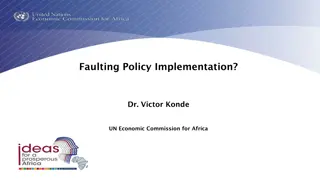Overview of Industrial Policy in India
Industrial policy in India encompasses a set of standards and measures established by the government to regulate and enhance the growth of the manufacturing sector, thereby contributing to economic development. It aims to maintain productivity, create employment opportunities, optimize human resources, and align with international standards. Historical industrial policy resolutions from 1948 to 1980 shaped the framework for industrial development in India, emphasizing sectors such as public, mixed, and private industries while promoting competition, liberalization, and technological advancement.
Download Presentation

Please find below an Image/Link to download the presentation.
The content on the website is provided AS IS for your information and personal use only. It may not be sold, licensed, or shared on other websites without obtaining consent from the author. Download presentation by click this link. If you encounter any issues during the download, it is possible that the publisher has removed the file from their server.
E N D
Presentation Transcript
Industrial Policy Industrial Policy is the set of standards and measures set by the Government to evaluate the progress of the manufacturing sector that ultimately enhances economic growth and development of the country. The government takes measures to encourage and improve the competitiveness and capabilities of various firms.
Objectives of Industrial Policy To maintain steady growth in productivity. To create more employment opportunities. Utilize the available human resources better. To accelerate the progress of the country through different means. To match the level of international standards and competitiveness.
Industrial Policy in India Industrial Policy Resolution, 1948 It declared the Indian economy as Mixed Economy. Small scale and cottage industries were given the importance. The government restricted foreign investments Industries were divided into 4 categories Exclusive monopoly of central government(arms and ammunitions, production of atomic energy and management of railways) New undertaking undertaken only by state(coal, iron and steel, aircraft manufacturing, ship building, telegraph, telephone etc.) Industries to be regulated by the government(Industries of basic importance) Open to private enterprise, individuals and cooperatives(remaining)
Industrial Policy Resolution, 1956 (IPR 1956) This policy laid down the basic framework of Industrial Policy. This policy is also known as the Economic Constitution of India. It is classified into three sectors Schedule A which covers Public Sector (17 Industries) Schedule B covering Mixed Sector (i.e. Public & Private) (12 Industries) Schedule C only Private Industries This has provisions for Public Sector, Small Scale Industry, Foreign Investment. To meet new challenges, from time to time, it was modified through statements in 1973, 1977, and 1980.
Industrial Policy Statement, 1977 This policy was an extension of the 1956 policy. The main was employment to the poor and reduction in the concentration of wealth. This policy majorly focused on Decentralization. It gave priority to small scale Industries. It created a new unit called Tiny Unit . This policy imposed restrictions on Multinational Companies (MNC).
Industrial Policy Statement, 1980 The Industrial Policy Statement of 1980 addressed the need for promoting competition in the domestic selective Liberalization, and technological up-gradation. It liberalised licensing and provided for the automatic expansion of capacity. Due to this policy, the MRTP Act (Monopolies Restrictive Trade Practices) and FERA Act (Foreign Exchange Regulation Act, 1973) were introduced. The objective was to liberalize the industrial sector to increase industrial productivity and competitiveness of the industrial sector. The policy laid the foundation for an increasingly competitive export- based and for encouraging foreign investment in high-technology areas. market, modernization,























